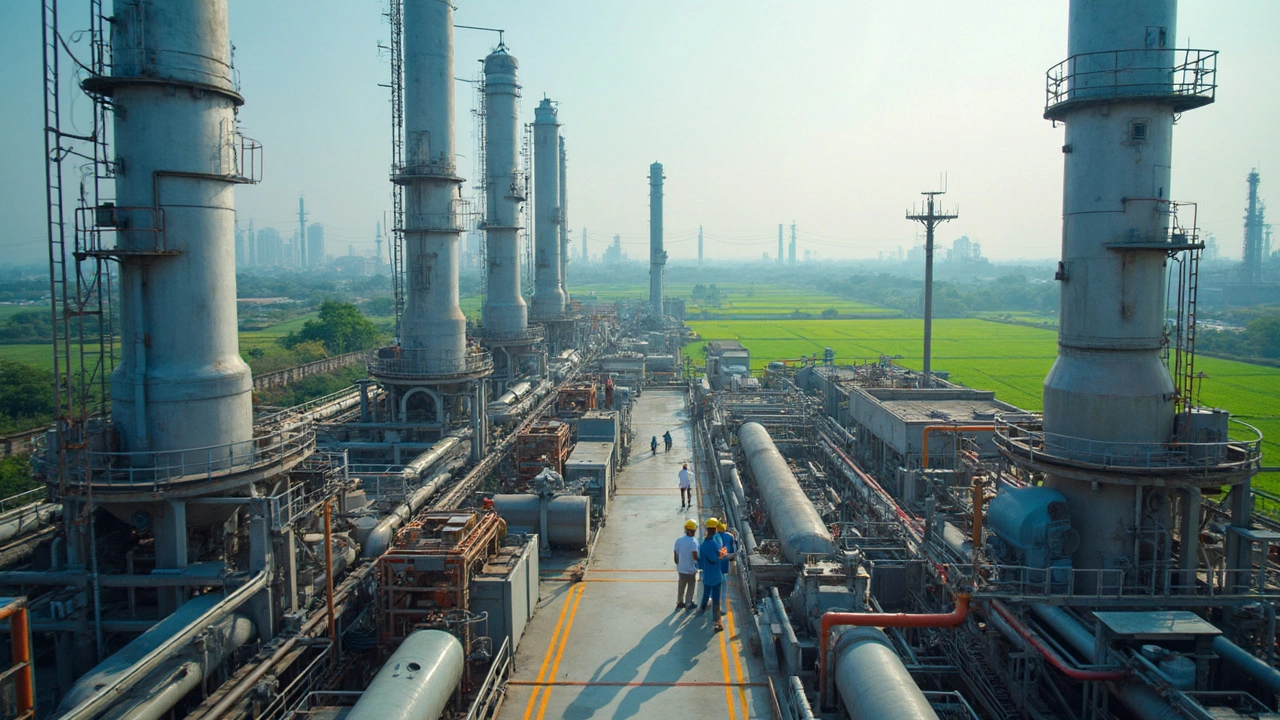Which is the Largest Chemical Manufacturer in India?

India's chemical industry plays a significant role in the nation's economy, making up a large portion of the country's GDP and providing numerous employment opportunities. It's not just the scale that makes it impressive but also the innovation and diversity within the sector. So, who takes the crown as the largest chemical manufacturer in this massive industry?
Reliance Industries Limited (RIL) stands tall as the leading name, dominating the chemical manufacturing scene in India. Known for its vast production facilities and extensive product portfolio, RIL continues to set benchmarks not just locally but on the global stage. They've got a hand in everything from petrochemicals to high-grade polymers, making them a powerhouse in the chemical world.
- Overview of India's Chemical Industry
- The Largest Chemical Manufacturer
- Key Milestones and Achievements
- Impact and Future Prospects
Overview of India's Chemical Industry
India's chemical industry is one of the most important components of its economy, contributing about 7% to the national GDP and providing livelihoods to millions. It's not just about the numbers; the industry is incredibly diverse, producing chemicals ranging from basic raw materials to specialty products used in high-end consumer goods.
The Indian chemical industry ranks among the largest in the world, standing at the 6th position globally and the 3rd in Asia. You might wonder what drives such an expansive industry. Well, it benefits immensely from a large domestic market, skilled workforce, and supportive government policies aimed at boosting production and exports.
The Backbone: Variety of Chemicals
The industry is broadly divided into two segments: bulk chemicals and specialty chemicals. Bulk chemicals include everything from fertilizers to industrial gases, forming the backbone of industrial production in India. Specialty chemicals, on the other hand, cater to specific, niche markets with higher margins, like agrochemicals and personal care ingredients.
Global Exporter
India is not just about serving its own massive population; it's one of the major chemical exporters worldwide. The country exports chemicals to countries like the USA, China, and several in Europe, strengthening its position in international markets. This presents a fantastic opportunity for future growth as demand for Indian chemicals grows globally.
Over the years, the Indian government has launched several initiatives to ramp up investments and bring in cutting-edge technology. Policies like 'Make in India' and a focus on sustainability have been pivotal in encouraging the production of 'green' and sustainable chemicals.
| Stat | Figure |
|---|---|
| Global Rank | 6th |
| GDP Contribution | 7% |
| Employment Generation | 2+ Million |
In a nutshell, the Indian chemical industry is like a hidden champion, resilient and ever-growing, ready to meet not just local needs but also make a mark globally.
The Largest Chemical Manufacturer
When you're talking about the largest chemical manufacturer in India, Reliance Industries Limited (RIL) undeniably takes the spotlight. Founded by the legendary Dhirubhai Ambani, this conglomerate has been pivotal in transforming the Indian chemical landscape. Let's dive into what makes RIL a giant in the industry.
Expansive Production Capacities
RIL's plant network is truly something to admire. They have established some of the largest and most integrated petrochemical complexes globally. With plants located in Jamnagar, Hazira, and various other locations, they have the capacity to produce an enormous range of chemicals, from basic ones like olefins to more advanced polymers.
In fact, their Jamnagar refinery is considered among the biggest petroleum refining hubs in the world. The integration of refining and petrochemical operations here enables Reliance to maximize efficiency and output.
Key Products and Innovations
RIL's product basket is as diverse as it gets. They produce a wide range of chemical products including polymers, elastomers, and fiber intermediates. Not just that, they've been pushing the envelope in bioplastics and sustainable practices. Their innovation lab consistently churns out eco-friendly solutions, adapting to global trends and demands.
Financial Muscle and Market Reach
Financially, RIL is a powerhouse. Their revenue figures are staggering, making them not only the leader in India but a noteworthy competitor on the global stage. Their financial clout allows them to invest heavily in R&D and infrastructure, keeping them ahead of the curve.
Partnerships and Collaborations
Reliance's growth is also fueled by smart collaborations. From joint ventures to strategic alliances, they have partnered with international giants like BP and Dow Chemicals to boost their presence and technological capabilities.
These alliances have opened up new markets and technologies for RIL, driving innovation and expansion.
Challenges and Future Prospects
Despite their dominance, the road isn't without challenges. Regulatory hurdles, environmental concerns, and international competition are continuous battles. However, RIL is committed to sustainability-focused growth and adopting greener practices, which can ensure their leadership for years to come.

Key Milestones and Achievements
When talking about Reliance Industries Limited, you can't overlook the incredible journey they've had in the chemical industry. From humble beginnings, they've grown into a global giant. Let's walk through some of the key moments that defined their path.
Foundation and Early Growth
It all started back in 1966 with a textile manufacturing unit, but by the late 70s, Reliance had already set its sights on the petrochemical sector. By 1985, they were producing fabric, textiles, and yarn, essentially paving the way for their future expansions.
The Petrochemical Era
The 1990s were a game-changer. RIL's massive naphtha cracking plant in 1991 opened doors to new products and markets. This move allowed the company to integrate further into backward manufacturing, producing essential chemicals from raw hydrocarbon materials.
Global Recognition
In 2001, RIL was recognized as India's largest private sector company, not just in chemicals but across all industries. This period marked their debut on the global scene as a key player.
Recent Developments
Today, Reliance is all about innovation and sustainability. Their latest ventures include the development of sustainable petrochemical solutions, such as moving towards greener alternatives and enhancing recycling capabilities.
Financial Performance
| Year | Revenue (in Billion USD) |
|---|---|
| 2010 | 45.6 |
| 2015 | 58.9 |
| 2020 | 80.1 |
This table shows the steady growth in revenue, highlighting how Reliance has thrived over the years.
With its vast network and ongoing developments, Reliance is not just India's largest chemical manufacturer but a vital component of the global chemical industry landscape. Keeping an eye on their future plans can give us hints about where the industry is headed next.
Impact and Future Prospects
Few industries impact the economy like the chemical sector, and Reliance Industries Limited is at the forefront in India. Their operations have been pivotal in shaping economic growth, not only by contributing to employment but also by enabling other industries to thrive, thanks to their vast array of chemical products.
The environmental impact is a significant consideration as well. RIL has made strides in sustainability, investing heavily in greener technologies and processes. Initiatives focus on reducing emissions and improving waste management, setting an example for other chemical manufacturers in India.
Economic Contributions
In terms of economic footprint, Reliance's contributions are massive. For instance, they help sustain countless ancillary industries, from agriculture with fertilizers to textiles with synthetic fibers. The company consistently pushes the boundaries of what's possible, often being a pioneer in introducing new products and technologies to the market.
| Year | Revenue (Billion USD) |
|---|---|
| 2022 | 80.5 |
| 2023 | 83.1 |
| 2024 | 85.7 |
That's not all. With financial resources being funneled into research and development, RIL is setting the stage for enhanced production capabilities and the introduction of high-performance products that meet the changing needs of consumers worldwide.
Future Prospects
When you peek into the future, it's clear there is still plenty on the horizon for India's chemical industry. Reliance is expected to ramp up its role in areas like specialty chemicals and pharmaceuticals, sectors that promise high growth due to increasing demand. The company's future success lies in its ability to innovate and sustain its competitive edge globally.
To sum it up, the impact RIL has in India and even beyond borders is undeniable. With their trajectory firmly set on adapting to new challenges, their role as the largest chemical manufacturer remains as solid as ever. It's a thrilling time for the industry, with innovation leading the way into a sustainable, prosperous future.
